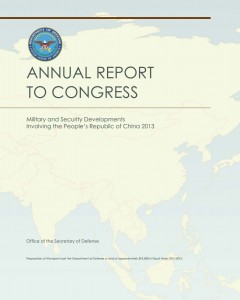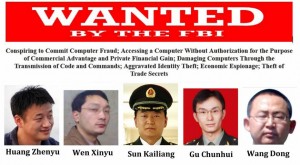 This new Department of Defense report is required reading:
This new Department of Defense report is required reading:
Military and Security Developments Involving the People’s Republic of China 2013 (US Department of Defense)
Excerpts from the report:
Espionage Supporting Military Modernization
China utilizes a large, well organized network of enterprises, defense factories, affiliated research institutes, and computer network operations to facilitate the collection of sensitive information and export-controlled technology, as well as basic research and science that supports U.S. defense system modernization.
Many of the organizations comprising China’s military industrial complex have both military and civilian research and development functions.
This network of government-affiliated companies and research institutes often enables the PLA to access sensitive and dual use technologies or knowledgeable experts under the guise of civilian research and development.
The enterprises and institutes accomplish this through:
- technology conferences and symposia
- legitimate contracts and joint commercial ventures
- partnerships with foreign firms
- joint development of specific technologies
As in previous years, China utilized its intelligence services and employed other illicit approaches that involve violations of U.S. laws and export controls to obtain key national security technologies, controlled equipment, and other materials not readily obtainable through commercial means or academia.
Based on investigations conducted by the law enforcement agencies of the Department of Defense, Department of Justice, Department of Homeland Security,and Department of Commerce, China continues to engage in activities designed to support military procurement and modernization.
These include economic espionage, theft of trade secrets, export control violations, and technology transfer.
• In August 2010, Noshir Gowadia was convicted of providing China with classified U.S. defense technology. This assisted China in developing a low signature cruise missile exhaust system capable of rendering a cruise missile resistant to detection by infrared missiles.
• In September 2010, Chi Tong Kuok was convicted for conspiracy to illegally export U.S. military encryption technology and smuggle it to Macau and Hong Kong. The relevant technology included encryption, communications equipment, and Global Positioning System (GPS)equipment used by U.S. and NATO forces.
• In September 2010, Xian Hongwei and Li Li were arrested in Hungary and later extradited to the United States for conspiring to procure thousands of radiation-hardened Programmable Read Only Microchips, classified as defense items and used in satellite systems, for the China Aerospace and Technology Corporation. Both defendants pleaded guilty and were sentenced in September 2011 to two years in prison.
• In January 2012, Yang Bin was arrested in Bulgaria and later extradited to the United States based on a December 2011 criminal indictment related to the attempted export of military-grade accelerometers used in “smart” munitions, aircraft, and missiles.
• In July 2012, Zhang Zhaowei, a naturalized Canadian citizen, was arrested while entering the United States, based on a sealed January 2011 indictment alleging Zhang attempted to illegally acquire and export military gyroscopes used in unmanned aerial systems and for tactical missile guidance.
• In September 2012, Zhang Mingsuan was arrested in the United States and indicted after attempting to acquire up to two tons of aerospace-grade carbon fiber. In a recorded conversation, Zhang claimed he urgently needed the fiber in connection with a scheduled Chinese fighter plane test flight.
In addition, multiple cases identified since 2009 involved individuals procuring and exporting export controlled items to China.
These efforts included attempts to procure and export:
- radiation-hardened programmable semiconductors and computer circuits used in satellites
- restricted microwave amplifiers used in communications and radar equipment
- export-restricted technical data
- thermal imaging cameras
There were also at least two cases in 2011 in which U.S. companies working on Department of Defense contracts subcontracted manufacturing work on small arms and replacement parts to Chinese companies in violation of the Arms Export Control Act.
ADVANCED TECHNOLOGY ACQUISITION
China relies on foreign technology, acquisition of key dual-use components, and focused indigenous research and development (R&D) to advance military modernization.
The Chinese utilize a large, well-organized network to facilitate collection of sensitive information and export-controlled technology from U.S. defense sources.
Many of the organizations composing China’s military-industrial complex have both military and civilian research and development functions.
This network of government-affiliated companies and research institutes often enables the PLA to access sensitive and dual-use technologies or knowledgeable experts under the guise of civilian research and development.
The enterprises and institutes accomplish this through technology conferences and symposia, legitimate contracts and joint commercial ventures, partnerships with foreign firms, and joint development of specific technologies.
In the case of key national security technologies, controlled equipment, and other materials not readily obtainable through commercial means or academia, China has utilized its intelligence services and employed other illicit approaches that involve violations of U.S. laws and export controls.
A high-priority for China’s advanced technology acquisition strategy is its Civil Military Integration policy to develop an innovative dual-use technology and industrial base that serve both military and civilian requirements.
China’s defense industry has benefited from integration with its expanding civilian economy and science and technology sectors, particularly sectors with access to foreign technology.
Examples of technologies include:
- advanced aviation and aerospace (hot section technologies, avionics and flight controls)
- source code
- traveling wave tubes
- night vision devices
- monolithic microwave integrated circuits
- information and cyber technologies
Differentiating between civil and military end use is very challenging in China due to opaque corporate structures, hidden asset ownership, and the connections of commercial personnel with the central government.
Some commercial entities are affiliated with PLA research institutes, or have ties to and are subject to the control of government organizations such as the State-owned Assets Supervision and Administration Commission.
• In March 2012, Hui Sheng Shen and Huan Ling Chang, both from Taiwan, were charged with conspiracy to violate the U.S. Arms Export Control Act after allegedly intending to acquire and pass sensitive U.S. defense technology to China. The pair planned to photograph the technology, delete the images, bring the memory cards back to China, and have a Chinese contact recover the images.
• In June 2012, Pratt & Whitney Canada (PWC), a subsidiary of U.S. aerospace firm and defense contractor United Technologies Corporation (UTC), pleaded guilty to illegally providing military software used in the development of China’s Z-10 military attack helicopter.
UTC and two subsidiaries agreed to pay $75 million and were debarred from license privileges as part of a settlement with the U.S. Department of Justice and State Department.
PWC “knowingly and willfully” caused six versions of military electronic engine control Hamilton Sundstrand in the United States to PWC in Canada and then to China for the Z- 10, and made false and belated disclosures about these illegal exports.
• In September 2012, Sixing Liu, aka “Steve Liu,” was convicted of violating the U.S. Arms Export Control Act and the International Traffic in Arms Regulations (ITAR) and possessing stolen trade secrets.
Liu, a Chinese citizen, returned to China with electronic files containing details on the performance and design of guidance systems for missiles, rockets, target locators, and unmanned aerial vehicles.
Liu developed critical military technology for a U.S. defense contractor and stole the documents to position himself for employment in China.
Cyber Activities Directed Against the Department of Defense
In 2012, numerous computer systems around the world, including those owned by the U.S. government, continued to be targeted for intrusions, some of which appear to be attributable directly to the Chinese government and military.
These intrusions were focused on exfiltrating information.
China is using its computer network exploitation (CNE) capability to support intelligence collection against the U.S. diplomatic, economic, and defense industrial base sectors that support U.S. national defense programs.
The information targeted could potentially be used to benefit China’s defense industry, high technology industries, policymaker interest in US leadership thinking on key China issues, and military planners building a picture of U.S. network defense networks, logistics, and related military capabilities that could be exploited during a crisis.
Although this alone is a serious concern, the accesses and skills required for these intrusions are similar to those necessary to conduct computer network attacks.
China’s 2010 Defense White Paper notes China’s own concern over foreign cyberwarfare efforts and highlighted the importance of cyber-security in China’s national defense.
Cyberwarfare in China’s Military
Cyberwarfare capabilities could serve Chinese military operations in three key areas.
- First and foremost, they allow data collection for intelligence and computer network attack purposes.
- Second, they can be employed to constrain an adversary’s actions or slow response time by targeting network-based logistics, communications, and commercial activities.
- Third, they can serve as a force multiplier when coupled with kinetic attacks during times of crisis or conflict.
Developing cyber capabilities for warfare is consistent with authoritative PLA military writings.
Two military doctrinal writings, Science of Strategy, and Science of Campaigns identify information warfare (IW) as integral to achieving information superiority and an effective means for countering a stronger foe.
Although neither document identifies the specific criteria for employing computer network attack against an adversary, both advocate developing capabilities to compete in this medium.
What China is looking for:
As part of a broad effort to expand basic research capabilities, China identified five areas that have military applications as major strategic needs or science research plans requiring active government involvement and funding:
- Material design and preparation;
- Manufacturing in extreme environmental conditions;
- Aeronautic and astronautic mechanics;
- Information technology development; and
- Nanotechnology research.
In nanotechnology, China has progressed from virtually no research or funding in 2002 to being a close second to the United States in total government investment.
Leading-edge Technologies
China is focusing on the following technologies for rapid development:
- Information Technology: Priorities include intelligent perception technologies, ad hoc networks, and virtual reality technologies;
- New Materials: Priorities include smart materials and structures, high-temperature superconducting technologies, and highly efficient energy materials technologies;
- Advanced Manufacturing: Priorities include extreme manufacturing technologies and intelligent service advanced machine tools;
- Advanced Energy Technologies: Priorities include hydrogen energy and fuel cell technologies, alternative fuels, and advanced vehicle technologies;
- Marine Technologies: Priorities include three-dimensional maritime environmental monitoring technologies, fast, multi-parameter ocean floor survey technologies, and deep-sea operations technologies; and
- Laser and Aerospace Technologies: Priorities include development of chemical and solid laser state technologies to ultimately field a weapons-grade system from ground-based and airborne platforms.
Key Fields and Priority Subjects
China has identified certain industries and technology groups with potential to provide technological breakthroughs, remove technical obstacles across industries, and improve international competitiveness.
Specifically, China’s defense industries are pursuing advanced manufacturing, information technology, and defense technologies.
Examples include radar, counter-space capabilities, secure C4ISR, smart materials, and low-observable technologies.
Major Special Items
China has also identified 16 “major special items” for which it plans to develop or expand indigenous capabilities.
These include:
- core electronic components
- high-end universal chips and operating system software
- very large-scale integrated circuit manufacturing
- next generation broadband wireless mobile communications
- high-grade numerically controlled machine tools
- large aircraft
- high resolution satellites
- lunar exploration












You must be logged in to post a comment.